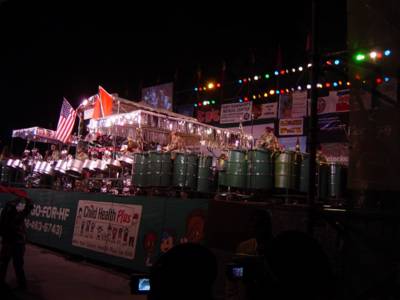We were a comparatively tiny 15-piece party band, although that's much larger than most college party bands. We played a range of gigs aside from parties, but we were all about grooving and shaking booty. There was one year that we had the connections to be invited to play at Lincoln Center, opening for a real steel drum event, but we were so amped just to play at Lincoln Center, I have no memory of seeing the real orchestras play.
Steel orchestras are upwards 100 members and are a sound to behold, albeit an acquired taste perhaps. The arrangements are mad complicated and there are times I'll be listening to a CD and bust out laughing at some cool counterpoint or sick run that I would notice for the first time.
Unlike the mellow beach or lounge stereotype associated with steel drums, the "real thing" is a bombastic, kinetic wall of percussion. How many harmonic ensembles in the world are there that consist of more than a hundred pieces of percussion? The rhythm section is called the "engine room" because for the 10-minute length of the pieces, they just chug along, guiding the orchestra through a range of latin rhythms.
It was mind-blowing being there. The level of musical and technical proficiency was amazing, and consider that these orchestras aren't incredibly well-funded and have their roots in street gangs. I couldn't even get my head around what I heard about the arranger of a band teaching each part of the 10 minute piece section by section, instrument by instrument.
These aren't simple pieces with lots of repetition, either. Part of the judging in the competition considers key and rhythm changes, complexity of the arrangement, and variations on the main melody. Several CDs I have include in the liner notes a break down of one of the songs with minute to minute analysis so the listener can follow along and hear what's happening when.
Anyway:
Harmony Steel Orchestra on stage. There are four sets of 6-basses on this side of the stage and more on the other. The engine room is on the platform in the middle along with a bunch of leads and other melody instruments. It looks like their front line has a whole array of different pans. The bassists are the most fun to watch because they have to move around a lot. There are usually 3 notes per bass pan.

Pan Tonic running through their piece in the parking lot before going on stage.

Adlib Steel Orchestra running through their piece in the parking lot. You can see their engine room on the platform in the back. In the middle are some tenors, and up front, of course is a 6-bass. "War 2004" was the song they played.

I don't know what band this was, I shot this on my way out, making my way through a sea of pans that were yet to make it to the stage. This is a set of 9-basses with 4 notes per pan, increasing the range of this set. In comparison, lead pans have almost 3 octaves in a single pan, about 29 notes.

Finally, two sets of either 4-cellos or quads. I'm not sure what quads are or what range they play in. But the size of the notes and the skirts of these pans are the same as the cellos with 3 pans we had in college.

